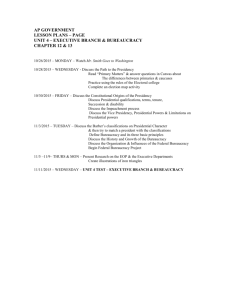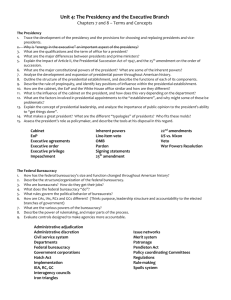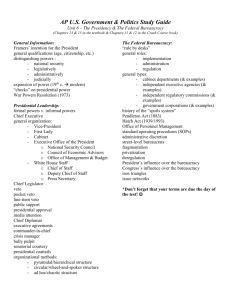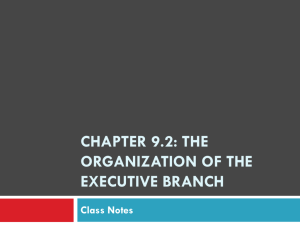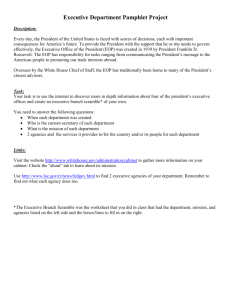THE WHITE HOUSE OFFICE
advertisement
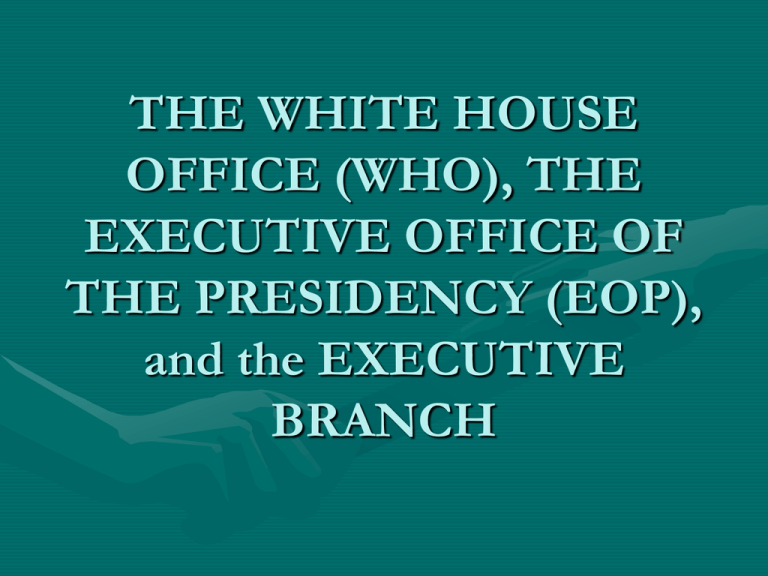
THE WHITE HOUSE OFFICE (WHO), THE EXECUTIVE OFFICE OF THE PRESIDENCY (EOP), and the EXECUTIVE BRANCH WHO – Chief of Staff • I. CHIEF OF STAFF: Managerial, Advisory, and Surrogate/Alter Ego Roles • A.) Manageria1 Role • 1.) Selecting personnel (but not always for latecomers) • 2.) Deciding on Structure of WHO (tight or loose) • 3.) Supervising Flow of Paper/People/Options/Decisions in and out of the WH • --must engage in “dual adaptation” • --be sensitive to presidential preferences on information acquisition • --compensate for weaknesses, guard against excessive tendencies • TWO DANGERS OF INFORMATION NOT GETTING TO THE PRESIDENT WHO— Chief of Staff • B.) Advisory Role • 1.) CoS is one of the few advisors who must integrate “policy” and “political” consequences • 2.) Protect president from mistakes and rushed decisions (Haldeman – Nixon) • 3.) Prevent president from making inflexible commitments---provide opportunities to back out (Panetta – Clinton) WHO— Chief of Staff • C.) “Alter Ego”/Surrogate Role 1.) President’s SOB or “bad cop” 2.) Useful surrogate in behind-the-scenes negotiations 3.) How much of a public figure in his/her own right? Sununu WHO – Office of Communications • Emerged after, and in response to needs unaddressed by, White House Press Office • 1.) More strategic and proactive than WHPO • 2.) Outreach to local and specialized press instead of Washington press corps 3.) Coordinate with other executive branch agencies to emphasize “theme of the day” ---Starting with Deaver, an emphasis on VISUALS WHO -- White House Office of Communications • • • • • • • The Presidential Communications Year January: budget and State of the Union speech Spring: promoting budget and legislation May-June: commencement addresses Summer: G-8 Summit September: Opening of UN Session October: Fiscal year deadlines WHO-Office of Communications • Speechwriting • Judson Welliver • FDR thru JFK: high-level policy advisers with high/early presidential involvement • LBJ: developed two-tier hierarchy of speeches and writers • Nixon: first to establish special speechwriting office; PR rather than policy emphasis • Ford, Carter, Reagan, Bush 41: conflict between policy and SW staff, little access to president, late presidential involvement • Clinton and Bush 43: the return of high presidential involvement and access and high (policy) status WHO – White House Counsel • Not the president’s personal lawyer, nor the nation’s lawyer, but the Presidency’s lawyer • FUNCTIONS • 1.) Provide legal advice before the fact, and legal defense after the fact: • ---executive privilege claims • ---war powers • ---presidential disability and succession ---executive orders • 2.) Assisting appoint of Federal Judges • 3.) Ethics training for WH employees • 4.) Legislative matters --- signing statements • 5.) Acting as intermediary between White House and DoJ WHO – Office of Legislative Affairs (sometimes known as Office of Congressional Relations or Office of Legislative Liaison) • History • Functions 1.) 2.) 3.) 4.) 5.) 6.) 7.) Direct lobbying and intelligence gathering Assuring WH speaks w/single voice Participating in formulation of legislation Patronage requests (e.g. senatorial courtesy) Orchestrating indirect lobbying/grassroots efforts Doling out presidential “goodies” Scorekeeping WHO – White House Press Office (Office of the Press Secretary) • • • • • • Main clientele: full-time White House Correspondents Change in function of press over time ---less intermediary function ---change to 24-hr. news cycle FUNCTIONS --daily press briefings and gaggles --press releases and background info --prepare Pres for press conferences • --crisis management • --handle logistics for White House Correspondents WHO – White House Press Office • HOW “in-the-loop” should Press Secretary be? • How much role in the policymaking process should he or she play? QUESTION: Is it better for the Press Secretary to be well-informed, and occasionally have to lie, or to be less well-informed and honest? Examples: Mike McCurry, Larry Speakes WHO – Other Offices • WHITE HOUSE STAFF SECRETARY • Manager of the president’s in-box and out-box (works with Chief of Staff) • Supervisor of the vetting process: “idea killer” • Manager of the mail • • • • OFFICE OF INTERGOVERNMENTAL AFFAIRS --Why created: Executive Order 12612 ---Nature of issues dealt with ---Work with IGOs WHO – Other Offices • OFFICE OF POLITICAL AFFAIRS • Under Karl Rove, replaced by “Office of Strategic Initiatives” • OFFICE OF PUBLIC LIAISON • --Created by Ford administration • --Outreach to new and hostile groups, care and feeding of supportive groups • --Orchestrate lobbying efforts on behalf of prez • --Stepping stone to bigger and better things WHO – Other Offices • Office of Presidential Personnel (will discuss later) • First Lady’s Office • Vice-President’s Office • Advance and Scheduling • Coming up next: THE EXECUTIVE OFFICE OF THE PRESIDENT! Exec. Office of the President (EOP): Office of Management & Budget (OMB) • 1.) Original function: (1921) Budgetary clearance 2.) Additional function (1930s): Legislative clearance • --executive branch proposals: in accord, no objection, not in accord --pending legislation in Congress: SAPs • 3.) Additional function (1930s): Enrolled Bill Procedure • 3.) Additional function (1980s): Regulatory clearance • Office of Information and Regulatory Affairs (OIRA) • Executive Order 12291: mandated CBA • Executive Order 12498: mandated annual regulatory programs • Apex of influence: David Stockman 1981-82, Richard Darman 1989-1992 Exec. Office of President (EOP) National Security Council (NSC) • Three different possible roles of National Security Adviser/National Security Council • 1.) integrator/coordinator/”honest broker” • 2.) one among equals: multiple advocacy • 3.) foreign/defense policy chief (Kissinger) • Which role did Dr. Rice play? What about Hadley? Exec. Office of the President (EOP) Domestic Council (a.k.a. OPD) • What preceded it: Cabinets, kitchen cabinets, “brain trusts,” task forces/commissions • Why Nixon created it • Ford, Carter (apex of influence) • Reagan: Cabinet Councils • Bush 41, Clinton EOP cont’d: Council of Economic Advisers (CEA) • Symbolized “arrival” of Keynesian Economics and economics as a science • Objective analysis or advocacy? • JFK: Walter Heller (apex of influence), tax cut • The “Troika” and the “Quadriad” • Stagflation, decline of the Keynesians, and the rise of the supply siders (the Laffer curve) and monetarists EOP Cont’d: Office of the Special Trade Representative (STR) • Why formed: “Kennedy round” of GATT, formation of Common Market (later EU), BoP problem • JFK got Cabinet-level status and staff and broad negotiating authority • Bush 41 and “FAST TRACK”: enabled NAFTA, “Uruguay Round” of GATT • Fast track is back! CAFTA EOP Cont’d: Office of Science and Technology Policy (OSTP) • Why created: Sputnik and Ike, atomic power • Similar dilemma to CEA: academic or political? • Expanding jurisdiction: from nukes and space to environment, health care, cloning and stem cells • Nixon abolished, Ford brought back • Often eclipsed by higher status science-oriented advisers (Sununu, Gore) EOP Cont’d: National Economic and Homeland Security Councils • NEC created by Clinton, kept by Bush • Don’t have anything else to say: go to White House website for info! • Hierarchy of WHO/EOP TITLES • --Assistant to the President (highest) • --Deputy Assistant to the President --Special Assistant to the President THE FEDERAL BUREAUCRACY – what’s in it • • • • • • • • • • 1.) Cabinet agencies: ex. Depts of Transportation, Labor, Justice, State, etc. ---older, more prestigious ---single-headed (Secretary) ---implementation-oriented, some regulatory authority ---president has full removal power 2.) Independent (non-Cabinet) agencies) ex. NASA, EPA, CIA, SBA, Peace Corps ---newer, more specialized ---single-headed (Director) ---implementation-oriented, more regulatory authority • ---president has full removal power THE FEDERAL BUREAUCRACY---what’s in it • 3.) Independent regulatory commissions (IRCs) • Ex. FCC, FEC, FTC, NRC, SEC, Federal Reserve • ---multiple-headed (board or commission) ---broad regulatory (policy-making) and adjudication authority as well as executive authority---”mini-govts.” • ---commission/board members have long, staggered terms and can’t be removed by president for political reasons • • • • • 4.) Government corporations Ex. Amtrak, US Postal Service, TVA, FDIC ----Self-financed, with govt. subsidy ----Even more politically independent than IRCs ----Offer goods and services similar to, even in competition with, private corporations THE PRESIDENT AND THE FEDERAL BUREAUCRACY • REASONS WHY PRESIDENTIAL CONTROL OF THE EXEC BRANCH IS NOT ASSURED • 1.) Merit (civil service) system of hiring 2.) Agencies’ advantage in technical expertise • ---example of “principal-agent” problem 3.) Bureaucracy was created incrementally, with no rational plan in mind---plenty of anomalies • 4.) Agencies’ SOPs make change and adjustment difficult 5.) Bureaucrats develop strong sense of agency “mission” and agency “culture” PRES. & BUREAUCRACY • 6.) Constitutional ambiguity about whether President or Congress is the “real” master of bureaucracy 7.) Strong interest group influence on agencies • (“Capture Theory” and “the revolving door”) • The regulated becomes the regulator! (ex. CAB) • “Iron triangles” Presidential Influence on the Bureaucracy • TECHNIQUES FOR INFLUENCING BUREAUCRACY • 1.) Making maximum use of limited appointment power----pro’s and con’s of strict ideological screening • ---Civil Service Act of 1978: abolished bipartisan CSC, set up OPM and MSPB, created SES • 2.) Properly socializing and training appointees • 3.) Removal power • ---Legal issues Myers vs. US (1926), Humphreys Executor vs. US (1935) • ---Political difficulty of firing cabinet members Presidential Influence on the Bureaucracy • 3.) Removal Power Continued: How to get rid of uncooperative career civil servants? The Malek Manual • • • • • 4.) Budgeting power ---how OMB review process works ---”current services” budget ---budgeting techniques: incrementalism, PPBS, ZBB ---effects of, and responses to, budget cuts: 1981-82 EPA, “the Bureaucracy Strikes Back” Presidential Influence on the Bureaucracy • • • • • • • • • 5.) Reorganization Authority 6.) Executive Orders ---examples of famous ones ---legal justifications (Youngstown Sheet and Tube v. Sawyer) ---types of EOs a.) temporary measures until legislature acts b.) alternatives to failed legislation c.) attempts to pre-empt/forestall legislation d.) Federal govt. as role model e.) changing the regulatory process, in hopes of changing regulatory outcomes Presidential Influence on the Bureaucracy • 7.) Privatization/Contracting Out
